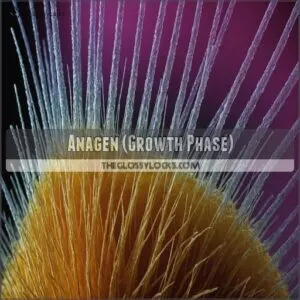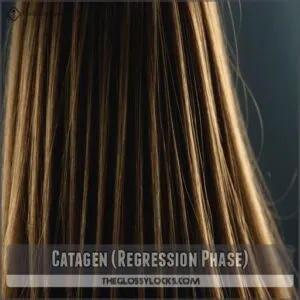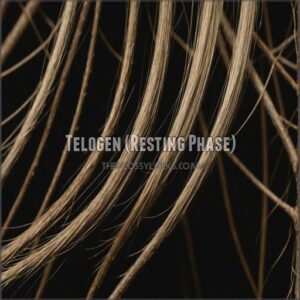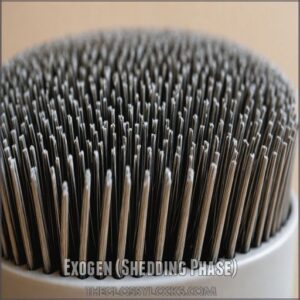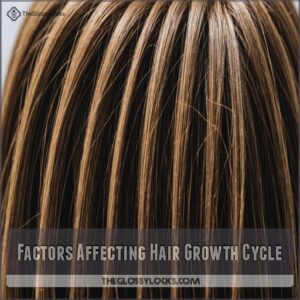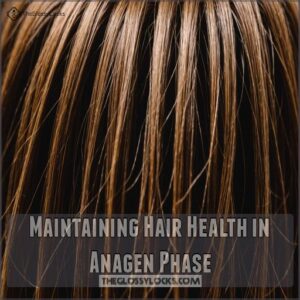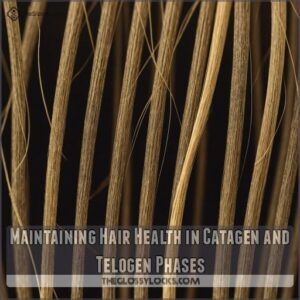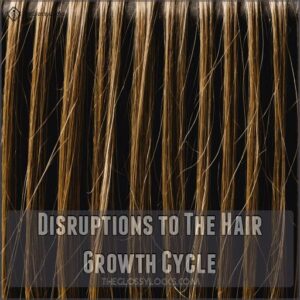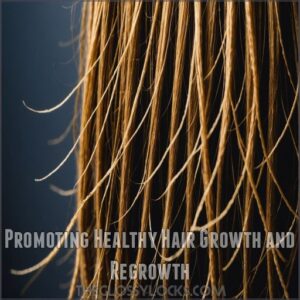This site is supported by our readers. We may earn a commission, at no cost to you, if you purchase through links.
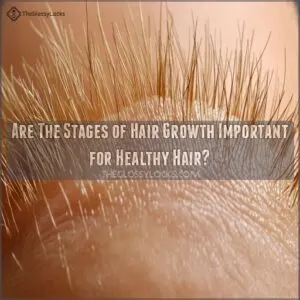 Ever wondered why some hairs seem to grow faster than a speeding bullet while others take their sweet time?
Ever wondered why some hairs seem to grow faster than a speeding bullet while others take their sweet time?
That’s because your hair follows a fascinating cycle called the stages of hair growth, which includes anagen (growth), catagen (regression), telogen (resting), and exogen (shedding).
Each phase has its own timeline, influenced by genetics, hormones, nutrition, and even stress.
Understanding these stages isn’t just scientific curiosity—it’s key to keeping your locks lush and healthy.
Curious to learn how each stage affects your hair’s health and growth?
There’s more to uncover about nurturing your hair through its natural journey.
Table Of Contents
- Key Takeaways
- Phases of Hair Growth
- Duration of Each Hair Growth Phase
- Factors Affecting Hair Growth Cycle
- Maintaining Hair Health in Anagen Phase
- Maintaining Hair Health in Catagen and Telogen Phases
- Disruptions to The Hair Growth Cycle
- Promoting Healthy Hair Growth and Regrowth
- Frequently Asked Questions (FAQs)
- What are the 4 phases of hair growth?
- What is the correct hair growth cycle?
- How do I know if my hair is in anagen phase?
- How do you know if your hair is in the resting phase?
- How do hair follicles get nutrients?
- Can stress affect hair growth stages?
- Is hair thickness related to growth phases?
- Do all hair types follow the same cycle?
- Can medication alter hair growth phases?
- Conclusion
Key Takeaways
- You’ll find your hair’s growth and health depend on understanding the four stages: anagen, catagen, telogen, and exogen. Each phase has a unique role in maintaining your hair’s cycle.
- Know that your genetics, hormones, nutrition, and stress levels all influence your hair growth cycle, impacting the length and health of your locks.
- During the anagen phase, your focus should be on nutrition and stress management to promote active growth and maintain strong, healthy hair.
- Managing stress and reducing damage during the catagen and telogen phases are crucial for preparing your hair for its next growth cycle and minimizing breakage.
Phases of Hair Growth
Understanding the various phases of hair growth is important since each stage plays a unique role in your hair’s overall health.
From growing to shedding, these phases guarantee your hair cycle remains continuous and balanced.
Anagen (Growth Phase)
The anagen phase is your hair’s growth spurt!
This active period, where your hair actually grows, lasts two to eight years per follicle.
Think of it as your hair’s marathon.
During this time:
- Anagen hair growth is rapid, about 0.3 mm daily.
- Anagen hair texture and color are determined.
- Anagen follicle health dictates thickness and strength.
Understanding your anagen duration helps you manage expectations and appreciate this important phase in the hair growth cycle.
Catagen (Regression Phase)
In the blink-and-you’ll-miss-it catagen phase, hair follicles shrink, taking a two-week break from growing, like a quick pit stop on a long road trip.
This brief pause marks a change in hair texture and color as it disconnects from blood supply.
Stress during catagen can add tension to your tresses, making this a key phase for healthy hair maintenance.
Telogen (Resting Phase)
Telogen, often referred to as the resting phase, plays a key role in your hair’s life cycle.
During this phase, hair doesn’t grow, and about 10-15% of your follicles are merely taking a break, awaiting their turn.
Understanding this phase helps in managing:
- Telogen effluvium triggers
- Hair loss insights
- Managing hair shedding
- Recognizing telogen phase duration
- Spotting hair cycle changes
Exogen (Shedding Phase)
Surprised by a full brush after washing your hair? You’re not alone!
During the exogen phase, hair shedding becomes your daily companion.
It’s normal to lose about 100 hairs a day.
Think of it as making room for new growth.
Your shedding rate can vary with triggers like stress or season changes, but this natural process keeps your locks in balance.
Duration of Each Hair Growth Phase
Understanding average hair growth duration involves knowing the lengths of each phase.
Think of it like a relay race, where different runners take turns.
Each phase has its own set time to shine.
For example, knowing how much hair grows in a month, typically between 0.5 to 1.7 centimeters, can provide valuable insights into the overall hair growth cycle average hair growth in a month.
- Anagen Phase: Known as the growing stage, lasts from 2 to 8 years. Longer anagen phases usually mean longer hair, as it’s when hair actively sprouts and lengthens.
- Catagen Phase: A pit stop in the cycle, shrinks over two weeks. This is like the cool-down lap after the intense growth, pausing the speed.
- Telogen Phase: A restful pause, lasting three to six months. Here, hair takes a much-needed breather before its next move.
These duration variations influence potential hair length and shedding patterns, serving as the foundation for understanding healthy hair cycles.
Factors Affecting Hair Growth Cycle
You’re probably wondering why your hair sometimes seems to have a mind of its own.
Genetics, hormones, nutrition, and stress all play a role in your hair growth cycle, influencing its health and strength.
Genetics and Hair Growth
While you’re pondering the duration of hair growth phases, consider this: genetics plays a major role in your hair growth patterns.
Your family history and genetic predisposition largely dictate hair loss inheritance.
Ever thought about DNA testing? It might reveal what your follicles are up to!
Like it or not, your genes are the boss of your hair’s destiny.
Hormonal Influence on Hair Growth
Hormones are key players in your hair’s growth story.
Think of them as the conductors of your hair’s orchestra!
Imbalances can throw things off, leading to hair loss.
Managing hair loss hormones properly can also help mitigate these issues, and products like those found on hair loss hormone solutions may be a useful resource.
Menopause often brings hormonal shifts, sometimes impacting hair growth.
Thyroid problems can also cause hair changes—thinning or excessive growth.
Pregnancy hormones can lead to thicker hair initially, due to increased estrogen levels that prolong the hair growth phase, resulting in thicker, fuller hair. Pregnancy hormones can lead to thicker hair initially, followed by shedding postpartum.
It’s all part of the hormonal rollercoaster!
Nutrition and Hair Growth
Hair growth thrives on good nutrition.
Without the right vitamins, like biotin and vitamin D, your hair mightn’t thrive.
Toss leafy greens, nuts, and fish into your hair growth diet to guarantee those strands get the nourishment they need.
Nutrition deficiencies can sneakily cause hair loss, so choose foods for healthy hair wisely!
Stress Impact on Hair Growth
Stress, that stubborn old frenemy, plays a surprising role in your hair’s wellbeing.
Stress-induced hair loss can sneak up, turning a good hair day into a thumb-twiddling encounter with your comb.
To keep those strands strong, try these:
- Stress management tips: Deep breathing, meditation.
- Hair loss prevention: Maintain a balanced diet.
- Hair growth recovery: Embrace relaxation rituals.
Maintaining Hair Health in Anagen Phase
During the anagen phase, your hair grows actively, making it very important to focus on nutrition, stress management, and gentle care practices.
Ensuring a balanced diet and reducing stress can help maintain excellent hair health and promote robust hair growth.
Nutrition and Diet for Hair Growth
Your hair’s lifecycle isn’t just shaped by genetics; what’s on your plate matters too.
Eating the right foods, such as those rich in iron and vitamin A sources, can greatly impact your hair growth.
Imagine you’re feeding a garden.
Hair growth vitamins like biotin and protein sources keep your locks thriving.
Consider diet supplements to guarantee balance.
Eating food for hair loss, such as leafy greens and nuts, can support your anagen phase, especially when combined with DHT blocking natural remedies, ensuring robust growth.
Stress Management Techniques
Managing stress is key to keeping your hair healthy during the anagen phase.
Try these techniques:
- Mindfulness: Practice being present to reduce anxiety.
- Yoga: This calms your mind and promotes circulation.
- Breathing Exercises: They help lower stress hormones.
- Meditation: Regular practice leads to better sleep and overall well-being.
Gentle Hair Care Practices
While life’s stressors can tangle your mind, tangles in your hair needn’t add to the chaos.
Embrace gentle hair care by using detangling tips like wide-tooth combs, especially after a scalp massage.
To support your hair growth, try incorporating Anagen phase hair care products.
Maintaining a healthy scalp is crucial for hair growth, and massaging the scalp with castor oil for hair growth can boost circulation. Opt for soft hair brushes to minimize breakage and hair products with natural remedies.
These simple practices keep your hair healthy, allowing you more freedom.
Maintaining Hair Health in Catagen and Telogen Phases
While you can’t actively grow hair during the catagen and telogen phases, you can still support healthy hair by minimizing damage and reducing stress.
Eating a protein-rich diet and managing stress levels are key to ensuring your hair is ready for the next growth cycle.
Protein Intake for Hair Health
To boost your hair’s well-being during the catagen and telogen phases, focus on dietary protein.
Think of proteins as the building blocks of luscious locks, especially with sources like lean meats, eggs, or vegan options like beans and lentils.
Avoid protein deficiency, which can make hair brittle.
Incorporate diverse protein sources into your hair growth diet for vibrant, healthy strands.
Stress Reduction Methods
Balancing your protein intake can encourage hair health, but managing stress in the catagen and telogen phases is just as important.
Understanding the connection between anxiety and hair loss can help you recognize potential triggers and develop strategies for managing stress.
Consider stress reduction with these practices:
- Mindfulness exercises: Focus the mind to ease tension.
- Yoga practice: Enhance relaxation and flexibility.
- Deep breathing: Instantly calms nerves and resets.
- Meditation techniques: Foster inner peace, reduce stress.
Minimizing Hair Damage
After tackling stress, let’s talk minimizing hair damage in those delicate catagen and telogen phases.
Limit hair breakage by easing up on heat styling and chemical treatments; they’re like kryptonite to your strands.
Master gentle brushing techniques and keep your scalp health in excellent condition.
Think of your scalp as a garden and you’re the diligent gardener, ensuring everything stays vibrant and flourishing.
Disruptions to The Hair Growth Cycle
When the hair growth cycle experiences disruption, you might notice unexpected changes in hair density and condition.
Understanding these disruptions, including various disorders and medical conditions, can help you take steps to maintain healthy hair.
Hair Loss Disorders and Conditions
You’re not alone if you’ve noticed thinning hair or bald patches.
Conditions like alopecia areata occur when your immune system turns rogue, targeting hair follicles.
Telogen effluvium often kicks in after stress or hormonal shifts, while trichotillomania involves pulling your own hair due to compulsion.
Hirsutism, on the other hand, surprises women with unwanted facial hair.
And then there’s traction alopecia—a hairdresser’s nightmare—from too-tight hairstyles.
Understanding these conditions can be the first step toward healthy hair.
Medical Treatments for Hair Loss
Understanding hair loss disorders is just the tip of the iceberg.
When it comes to battling baldness, you’re not short on options.
Knowing the hair loss stages helps in choosing the right treatment.
Hair loss medications, like minoxidil, can slow the shedding.
If you’re up for something a bit more intensive, surgical hair restoration offers a longer-lasting solution.
Emerging treatments like platelet-rich plasma therapy, laser therapy, and stem cell therapy offer fresh hope.
Choose wisely to regain control and boost confidence.
Promoting Healthy Hair Growth and Regrowth
Understanding the hair growth cycle is key to promoting healthy, vibrant hair.
You can encourage strong growth and regrowth by focusing on the right nutrition, stress management, and gentle hair care techniques.
Emerging Hair Growth Therapies
In the realm of boosting hair growth, exciting new therapies are on the horizon. Stem cell therapy aims to revitalize dormant hair follicles, which can sometimes be affected by complications such as wound-induced hair growth, while gene editing targets specific hair growth genes for potential benefits.
Hair growth supplements play a supporting role, nourishing the scalp from within.
Techniques like platelet-rich plasma injections and micro-needling improve scalp health, enhancing hair regrowth.
These approaches foster hope for healthier, thicker locks.
Addressing Common Hair Growth Myths
Moving from innovative hair growth therapies, let’s unravel some myths. Hair growth myths often buzz around, like saying trimming fast-tracks growth—truly, it just cuts split ends.
Scalp massage won’t make hair sprout overnight but can boost relaxation.
Using extravagant hair care products is tempting, yet they won’t always deliver promised results.
And hair brushing should be gentle—aim to detangle, not damage, ensuring healthier hair.
Frequently Asked Questions (FAQs)
What are the 4 phases of hair growth?
Hair growth cycles through Anagen (growth), Catagen (transition), Telogen (resting), and Exogen (shedding).
Most hair is in Anagen, actively growing, while Exogen involves daily shedding of up to 150 hairs, restarting the cycle.
What is the correct hair growth cycle?
Picture your hair on a journey; it sprouts in anagen, pauses in catagen, rests in telogen, and sheds in exogen.
Each phase plays a key role, ensuring your locks are constantly renewing and flourishing.
How do I know if my hair is in anagen phase?
You’re likely in the anagen phase if your hair’s actively growing, a process that can last for years! It’s the longest stage, so chances are, you’re experiencing it right now.
How do you know if your hair is in the resting phase?
To spot if your hair’s in the resting phase, notice less growth and more shedding than usual.
About 10% to 15% of hairs rest.
Shed strands might hit the pillow or brush more frequently.
How do hair follicles get nutrients?
Hair follicles receive nutrients through blood vessels connected at the dermal papilla.
These vessels deliver essential nutrients and oxygen, fueling hair growth.
Think of them as tiny highways, ensuring your hair gets everything it needs to thrive.
Can stress affect hair growth stages?
Around 100 hairs fall from your head daily—stress can increase this by pushing more follicles into the shedding phase.
Stress not only spikes hair loss but could also be a sign of telogen effluvium, a condition where sudden stress triggers hair loss, leaving you frustrated and follicle-focused.
Is hair thickness related to growth phases?
Yes, the thickness of your hair can relate to its growth phases.
During the anagen phase, the follicle is more active and can produce thicker hair strands compared to other phases when activity decreases.
Do all hair types follow the same cycle?
Imagine nature’s clockwork—though all hair types dance through the same growth cycle stages, genetics and hormones play a tune of their own, influencing how each strand grows, pauses, or sheds in unique ways.
Can medication alter hair growth phases?
Medications can indeed alter hair growth phases.
Some encourage growth, like minoxidil,
while others cause shedding or inhibit growth, such as chemotherapy drugs.
It’s like hair gets a mind of its own with these treatments.
Conclusion
Remember Rapunzel’s legendary locks?
Understanding the stages of hair growth is your key to similar success.
We’ve explored the anagen, catagen, telogen, and exogen phases.
Knowing the duration of each phase in the hair growth cycle helps you understand why some hairs grow faster than others.
Genetics, hormones, and nutrition all play a significant role.
By incorporating natural hair growth methods such as using home remedies for hair growth, like castor oil and scalp massage, and managing stress and following a healthy lifestyle, you can support your hair’s natural growth.
So, now you’re equipped to nurture your own magnificent mane, understanding the intricacies of the stages of hair growth.
Healthy habits lead to healthy hair!

